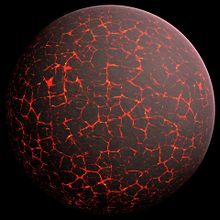
Back Geskiedenis van die Aarde Afrikaans تاريخ الأرض Arabic পৃথিৱীৰ ইতিহাস Assamese Historia de la Tierra AST Yerin tarixi Azerbaijani Гісторыя Зямлі Byelorussian История на Земята Bulgarian धरती के इतिहास Bihari পৃথিবীর ইতিহাস Bengali/Bangla Història de la Terra Catalan


The history of the Earth describes the most important events and stages in the development of the planet Earth from its formation to the present day.
The age of the Earth is about 4.56 billion years.[3] Nearly all branches of science have helped us understand the main events of the Earth's past. There has been constant geological change and biological evolution. The geological time scale (GTS), as defined by international convention, shows the large span of time from the beginning of the Earth to the present.
The Earth is about one-third the age of the universe. Earth formed as part of the birth of the Solar System.[4] What eventually became the solar system started as a large, rotating cloud of dust and gas. The Sun was composed of hydrogen and some helium. All the heavier elements were produced by stars long gone. They were picked up by the Sun on its travels in the Milky Way galaxy.
The earliest undisputed evidence of life on Earth dates at least from 3.5 billion years ago during the Eoarchean era. There are microbial mat fossils, such as stromatolites, found in 3.48 billion-year-old sandstone discovered in Western Australia.
Other work may push this estimate back even further. The origin of life on Earth was at least 3.77 billion years ago, possibly as early as 4.41 billion years ago.[5]
- ↑ Bowring, Samuel A.; Williams, Ian S. (1999). "Priscoan (4.00-4.03 Ga) orthogneisses from northwestern Canada". Contributions to Mineralogy and Petrology. 134 (1): 3–16. Bibcode:1999CoMP..134....3B. doi:10.1007/s004100050465. S2CID 128376754.
- ↑ Discovery of world's oldest rocks challenged
- ↑ Dalrymple, G. Brent 2004. Ancient Earth, ancient skies: the age of Earth and its cosmic surroundings. Stanford.
- ↑ Manhesa, Gérard; Allègre, Claude J.; Dupréa, Bernard & Hamelin, Bruno (1980). "Lead isotope study of basic-ultrabasic layered complexes: Speculations about the age of the earth and primitive mantle characteristics". Earth and Planetary Science Letters. 47 (3): 370–382. Bibcode:1980E&PSL..47..370M. doi:10.1016/0012-821X(80)90024-2.
- ↑ Staff (20 August 2018). A timescale for the origin and evolution of all of life on Earth. Phys.org. Retrieved 20 August 2018. [1]